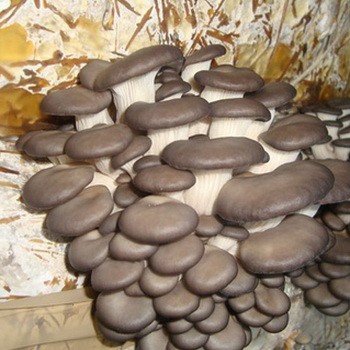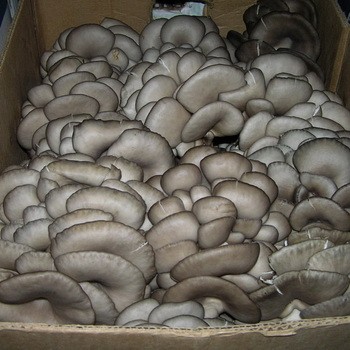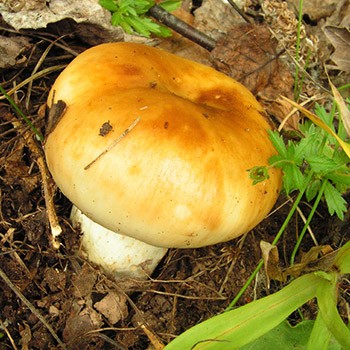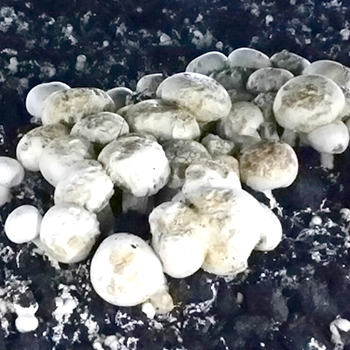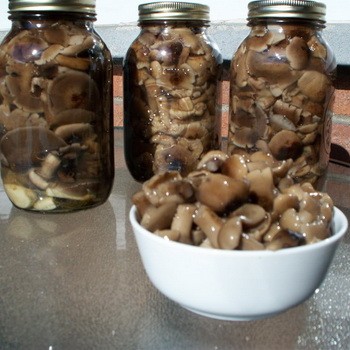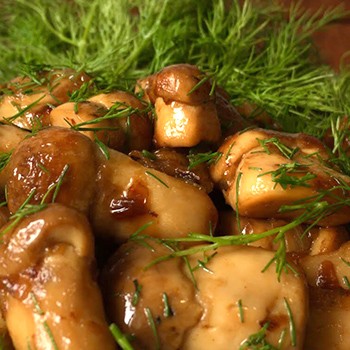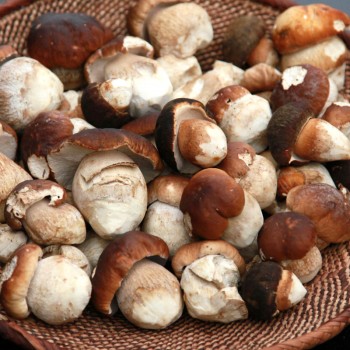Diseases and pests of fungi: description and methods of control
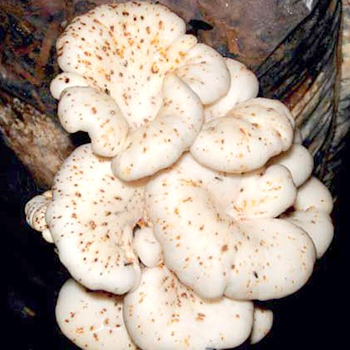
Mushroom cultivation is an interesting and well-controlled process. A plentiful crop depends on many factors. Sometimes the manufacturer does not manage to get a significant crop. This is influenced by abiotic and biotic factors. The first include such as relative humidity, temperature, moisture level in compost and soil. Biotic factors include diseases and pests of fungi. Diseases are able to appear at any stage of fungal development when negative factors occur. For example, in the formation of mycelium, compost with negative indicators can cause the onset of the disease. Biotic factors can be the biggest problem when growing mushrooms, as the diseases caused by them are similar in their symptoms. Indeed, for the treatment of the disease, it is necessary to eliminate its cause, which is rather difficult to determine due to the similarity of symptoms.
You can familiarize yourself with the names and descriptions of fungal diseases, as well as ways to combat them, in this article.
Content
Signs of fungal diseases
The most common biotic signs of fungal diseases are parasitic and antagonist fungi, viruses, bacteria and pests (nematodes, ticks, flies). In order to establish the disease, you will need the simplest equipment in the form of a binocular, a magnifying glass, etc. If you doubt your diagnosis, you will need to send samples to the laboratory for analysis.
Mushroom parasites, under favorable conditions for them, can greatly affect the cultivated mushrooms. Parasite fungi are distinguished by several signs. The most important of them is the spore-bearing structure. Most of these fungi do not infect mycelium, but fruiting bodies. The sooner the parasites appear, the more mushrooms will be damaged. They can simply suppress their development or completely destroy it.

The effect of antagonist fungi on cultivated mushrooms is poorly understood. More often they appear due to improperly prepared compost. Some species of such fungi grow and develop together with the mycelium of cultivated mushrooms, taking away their nutrients. Other antagonists appear after the development of mycelium and inhibitory effects on all parts of the mycelium, delaying its development and growth. In any case, they reduce the yield. Antagonist fungi can be seen in compost or on the surface of the soil by mycelium or by spores. They are also often called gypsum mold, lipstick, olive-colored mold.
Inventory used when working with mushrooms should not be used on other types of work. Otherwise, spores can be transferred from the soil to the substrate.
Weed mushrooms are also able to grow with cultivated ones. For example, ink mushroom is often found in champignon mushrooms. It develops with waterlogging of the substrate and the presence of free ammonia in it.
Ink mushrooms can only be collected every day and destroyed so that they do not stain the bags. Over time, they cease to appear. But the yield of cultivated mushrooms is declining, as ink mushrooms have used some of their nutrients.
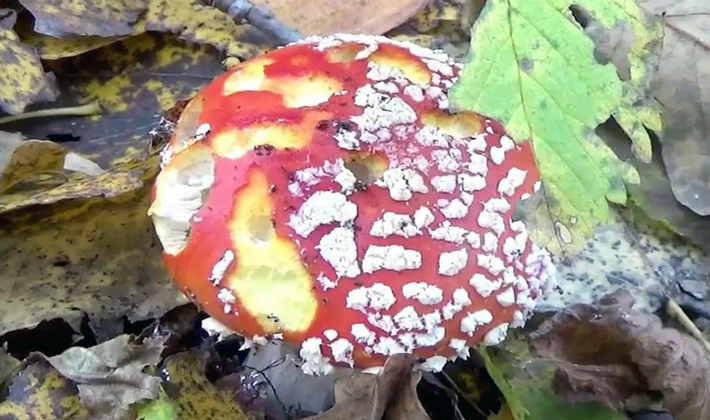
Gray dung beetle is a competitive mushroom oyster mushroom. It consumes their nutrients, thereby reducing yield. It should be removed from the plantation and destroyed. To prevent its appearance, you can not feed the plants near the beds with oyster mushrooms.
Bacteria play a dual role in mushroom cultivation. Some types of bacteria are simply necessary for the successful development of mycelium, for the substrate; others, on the contrary, cause serious illness. One of the most famous and serious diseases of cultivated fungi is caused by a bacillus. Bacteria are in the mycelium and do not affect its development. But they inhibit the growth of fruiting bodies, cause them to deform.
Mushroom Growing Diseases
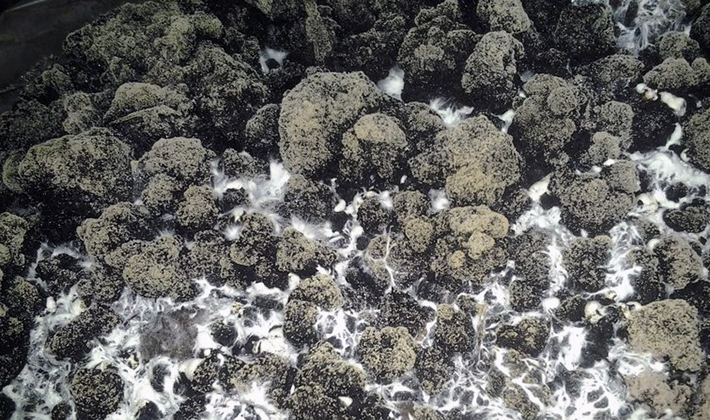
Brown plaster caused by brown mold fungus. More often affects champignons. It occurs in the presence of free ammonia in a raw or unripe substrate. Also, the reasons for its appearance may be increased humidity of the air and substrate and insufficient ventilation. The causative agent feeds on the same nutrients as mushrooms, so it is also called the fungus-comforter. White spots of various shapes appear on the layer of coating material or on the surface of the substrate. If the mycelium is rubbed with fingers, then a characteristic sweetish smell is felt. After some time, the spots begin to darken from the middle. So, spore formation begins. Disputes are brown-coffee color. White spots gradually disappear, and spores become invisible.
To prevent this disease, it is necessary to compost and pasteurize the substrate correctly. The room should be constantly ventilated, and the substrate pollinated with gypsum.
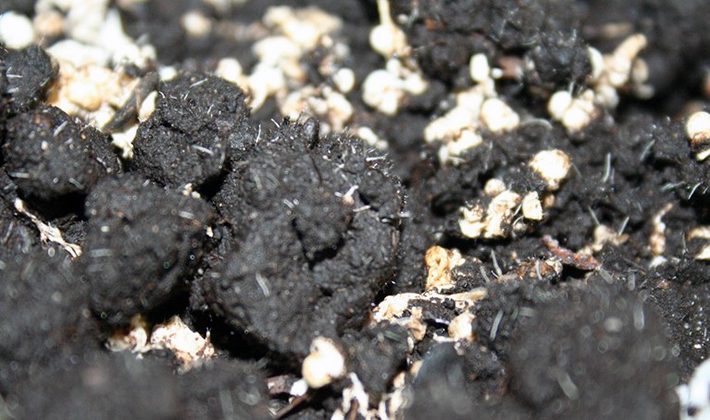
Truffle disease observed more often in double-ring champignon and is caused by Diehliomyces microsporias (Diehl and Lamb.) Gil. False truffle lives in the soil. It enters the substrate during composting on the ground. It begins to develop quite rapidly at high substrate temperatures. The false truffle mycelium is invisible at first. It inhibits the champignon mycelium, the fruiting of which is sharply reduced. Gradually, the mycelium of the cultivated fungus dies completely and the substrate becomes viscous, in it you can already see thick filaments of mycelium - rhizomorphs. On them, after some time, small bodies of mushrooms form, resembling the brain of a calf. These are the fruit bodies of the fungus. They are yellowish white. Then they darken and disappear, as they disintegrate into spores that affect a new substrate. Disputes are very viable. They can withstand heat treatment of the substrate.
To prevent this type of fungal disease, composting on the earthen floor cannot be carried out. In the shoulders, the temperature should be as high as possible. Compost areas should be mixed. After interrupting, the shoulders need to be sprayed with a 1% solution of copper sulfate. The coating layer should be thermally treated. Contaminated substrate should always be packed in bags before being dumped in a landfill. This will help prevent the transfer of spores from it to surrounding objects.

Bacterial spotting manifests itself in the form of dark spots on the mycelium. The cause of this disease is bacteriosis that develops in a waterlogged substrate. They can also appear if the substrate has undergone insufficient or improper heat treatment, or if the temperature is not observed during incubation of the substrate.To prevent this disease, fungal mycelium must strictly comply with all established rules at all stages of work and maintain the desired microclimate.
The substrate is also sometimes affected by trichoderma. The result of the disease are islets of green mold on it, which reduce yield. The infected substrate should be destroyed immediately. To prevent this disease, it is necessary to subject the substrate to thorough heat treatment. It is also noted that the selective substrate is less exposed to infection with this disease.
Sometimes mushrooms grow with a small hat on a thin long stalk. To correct this effect, it is necessary to ventilate the room. This can be done using a conventional fan or making a blower with nozzles from a plastic bag.
To prevent infection by bacteria, you should spray all rooms with a 2–4% solution of bleach twice a year. Then they must be closed for 2 days. Then aerate well for 2 days. Twice a year, all walls should be whitened with a 1% solution of bleach. All residues of the substrate must be carefully cleaned.

Rusty spotting manifested by clearly defined rust spots. Over time, they darken. Bacteria of this fungal disease appear at high humidity. This disease can quickly cover the entire plantation in a short time. To prevent illness, any disinfectant that contains chlorine should be added to water for irrigation.
Viruses or virus-like particles have any cultivated fungus. They come in various sizes and shapes. At the moment, the specific effect of viruses on the development of cultivated fungi is unknown. The only thing that can be said for sure is that all viruses and their particles lead to a decrease or even loss of yield, to various growth anomalies of fruiting bodies that cause a change in the shape of the fungus (early opening of the cap, too long legs).
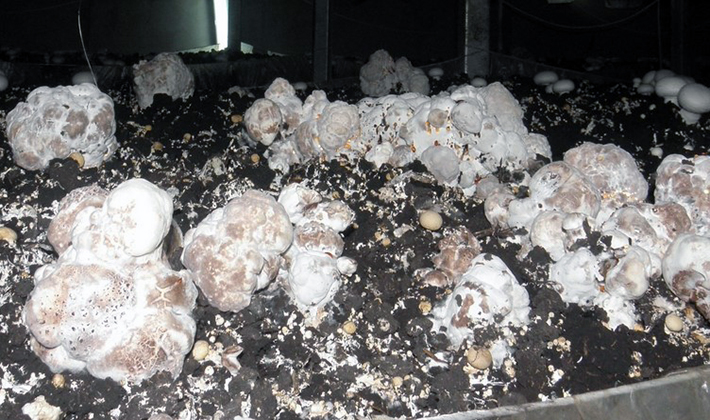
White rot - One of the most common diseases of cultivated mushrooms. She can ruin an entire plantation. The causative agent of this fungal disease is in the integument. It should be disinfected to prevent disease. Affected mushrooms must be removed and burned. Ridges need to be watered with a disinfectant chlorine solution.
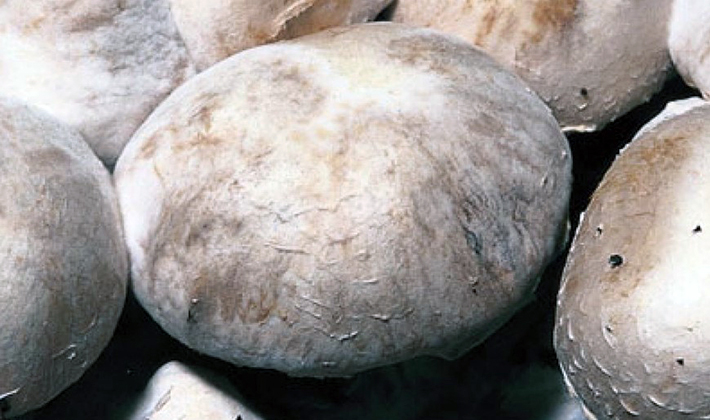
Dry rot cultivated mushrooms are also often affected. Its pathogen is located in the soil cover. It affects cultivated mushrooms - brown spots appear on them. The legs of the affected mushrooms become thick; in old mushrooms they even crack. Such mushrooms must be removed and destroyed immediately. To prevent this disease, it is necessary to disinfect the integument.
The main signs of fungal diseases are shown in these photos:
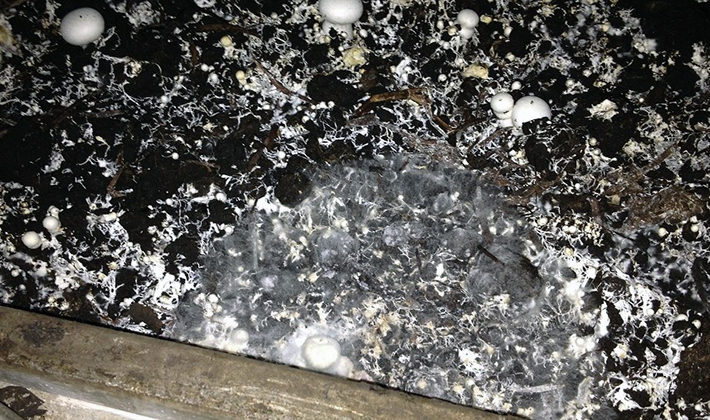
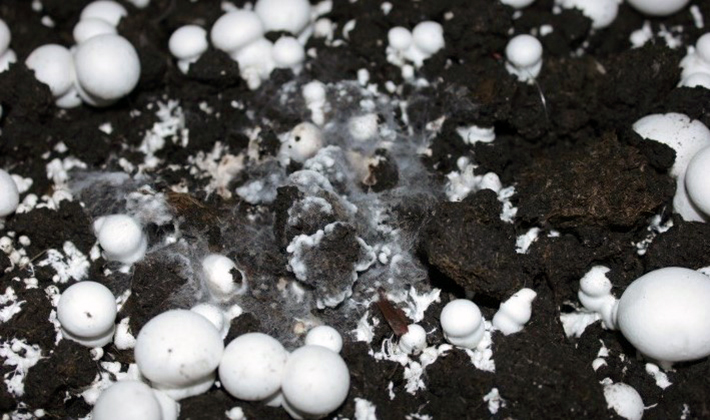
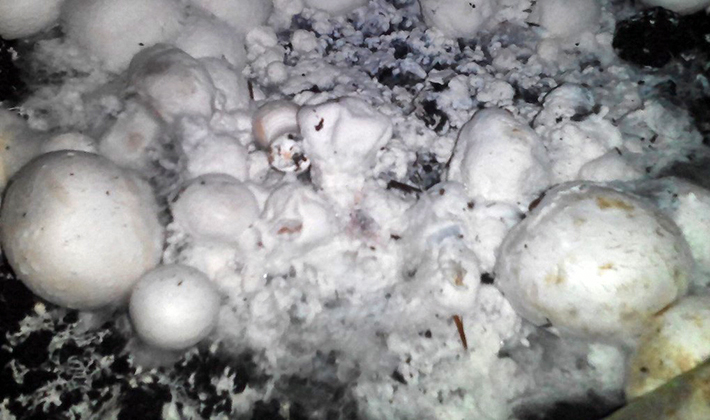
Pests of cultivated mushrooms
Pests of cultivated mushrooms are mushroom flies, ticks, mosquitoes, nematodes, and mouse rodents.
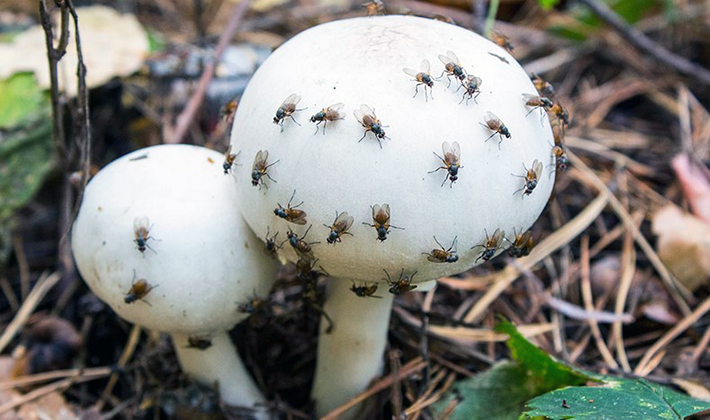
Mushroom flies often affect cultivated fungi and damage the mycelium and fruiting bodies, which, in turn, undergo bacterial infections. Flies fly by themselves, they are attracted to the mushroom smell. They can also be brought along with the substrate. More often flies infect mushrooms in warm weather, when the air temperature is above 17 ° C.
Mushroom flies massively develop during the period of growth and maturation of the mycelium. At this time, the substrate is indoors. Usually it is kept for 5–6 weeks, and larvae turn into adult flying flies within 24–38 days at an air temperature of 20–30 ° C. This period is most favorable for the development of pests with its comfortable indicators, such as temperature and humidity.
The first signs of the appearance of the larvae of these fungal pests are dark spots near the perforation of the mushroom block.
The danger increases if materials of different ages are stored in the room (flies and mosquitoes that are in the old block infect new ones).Pests penetrate holes in polyethylene and lay eggs. The larvae that emerge from them damage the mycelium, which, in turn, is infected by molds, bacteria.
The main measures to combat the mushroom fly are preventive. They should be carried out before seeding the mycelium into the substrate. All sources of infection must be removed before laying the substrate and with further care of the mushrooms. The room should be thoroughly cleaned and disinfected. If the air contains a large number of vapors and harmful gases, then it is advisable to use a gas mask during operation.
If the production of mushrooms is quite large, then special preparations can be used against adult insects. Before starting work, the entire room should be fumigated with a pair of Monofos or Poghos preparations (800 g per 1000 m). After that, the room must be closed for several hours. Then ventilate well and repeat the operation after a few days. These drugs are strong poisons, so you need to work with them very carefully. To combat flies, light traps, adhesive tapes, and hand vacuum cleaners are also used. They are also scared away by some smells, such as vanilla.
For the same purpose, it is better to equip incubation and cultivation rooms separately from each other.
Also, ordinary house flies are able to lay their larvae on a substrate.
In addition, slugs may appear on the substrate. They spoil the fruiting bodies of mushrooms. To combat slugs, use potassium salt or superphosphate, which is sprinkled with soil 3-4 times a year.
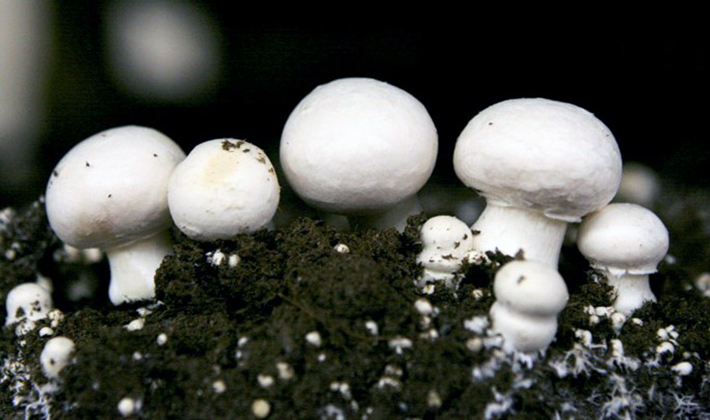
Mushroom mosquito is one of the most dangerous pests for champignons and oyster mushrooms. This is a very small insect only 3 mm long. Mosquitoes fly quickly and well, moving precisely to the room where it smells delicious of compost and mycelium. Each female is able to lay up to 200 eggs. After a few days, larvae appear on them, similar to white worms with a black head. Their length is 4–6 mm, and they can be easily seen with the naked eye. They live 12–20 days. During this time, the larvae manage to destroy the entire crop. They eat both mushrooms and mycelium. Product quality is also declining. In addition, mosquitoes carry ticks, spores of pathogenic microorganisms, nematodes.
Larvae gradually turn into pupae, then after 4–7 days into adult individuals.
These insects develop very quickly and have high fecundity. They almost instantly fill the entire mycelium. Therefore, it is very difficult to deal with them. It is important to prevent infection, that is, to prevent the first laying of pest eggs in the substrate. Why it is necessary to install fine-mesh nets on the ventilation openings. In the same room, you need to create excess pressure. All cracks should be closed, and the doors should be sealed; You can also hang glue traps, use regular adhesive tapes against flies. Also for this purpose, some gardeners use light traps, and special precautions must be taken.
If all of the above does not work, then you need to use chemical protective equipment.
They usually disinfect rooms between production cycles or treat the surface of the substrate and coating material when the mycelium is just starting to grow. But this should be done no later than 25 days before the start of the harvest.
If you violate the timing and dose of insecticides, then this can cause the appearance of ugly fruiting bodies, delay the growth of fungi, lead to the accumulation of the residual amount of pesticides in the fungi. Therefore, the most important rule of mushroom pickers is to never use pesticides during fruit formation.
Before starting work, all equipment and shoes should be disinfected with a 50% formalin solution. Then it must be washed off with water.
The working fluid needs to be spent quite sparingly: no more than 0.2 l / m in compost, and a little more in the coating material - 1 l / m. One of the best anti-mushroom mosquitoes are microbiological preparations based on Bacillus Thuringiensis. But their working dose is less - about 25-30 g / m, but these drugs are environmentally friendly.
You can also use folk remedies against mushroom mosquitoes. The beds need to be covered with tops of tomatoes, sprinkled with dill oil.
As preventive measures, maintaining order and cleanliness in and around the mushroom room should be mentioned. You also need to constantly remove the wormy fruiting bodies from the mycelium.
Table "Drugs approved against mushroom mosquitoes on mushroom crops":
| Name | Firm | Norm,
ml / m2 |
Max.
time |
Appointment | |||
| Carbo
fos |
Domestic | 0,5 | 1 | For
premises |
|||
| Anomet-
rin |
Domestic | 0,5 | 2 | Surface
substrate |
|||
| Actellic | ICC,
England |
0,5 | 2 | Surface
substrate |
|||
| Cymbush | ICC,
England |
0,5 | 2 | Surface
substrate |
|||
| Arrivo | FMS,
USA |
0,5 | 2 | Surface
substrate |
|||
| Nurell | Dow Elanco, USA | 0,6 | 2 | Surface
substrate |
|||
| Ripcord | Shell
England |
0,3 | 2 | Surface
substrate |
|||
| Rovinil | Hungary | 1,2 | 2 | Surface
substrate |
|||
| Dimilin | Dufar
Gollan diya |
1 «3 | 2 | Surface
substrate |
|||
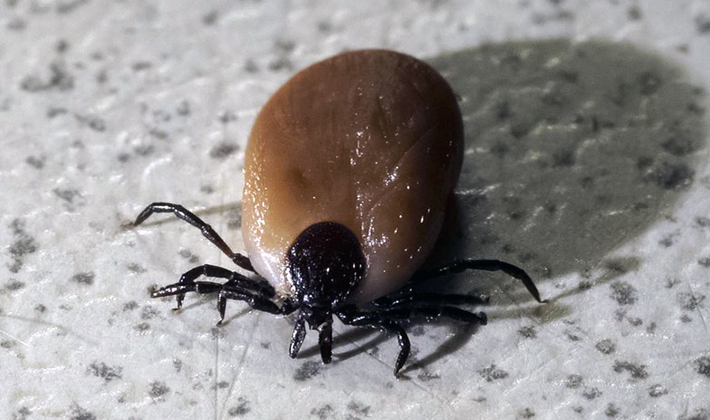
Ticks also are pests for fungi if they are grown on a straw substrate. Mites are smaller than mosquitoes in size - about 1 mm. Their body is oval, flat, yellow, white or pink. In adults, 4 pairs of legs, and in larvae - 3 pairs. The female lays up to 400 eggs. Ticks are able to move quickly and crawl under clothing, causing a very unpleasant itch. Tick larvae damage the mycelium, adult individuals make moves in the fruiting bodies.
Ticks enter the mycelium with straw. They develop rapidly in insufficiently pasteurized or poorly fermented substrate. In order to get rid of them, you just need to replace the straw.
Another type of tick gets into the substrate along with manure. The female lays about 40 eggs in a substrate or integumentary soil. The tick develops from a few days to a month. In fungi affected by ticks, the base of the leg turns brown, the hat turns pink.
To prevent the infection of the substrate with ticks, it must be kept at a temperature of 59 ° C for about 12 hours. The integumentary earth must be disinfected for 8 hours at a temperature of 60 ° C. Between the beds of mushrooms you need to spray with suitable preparations.
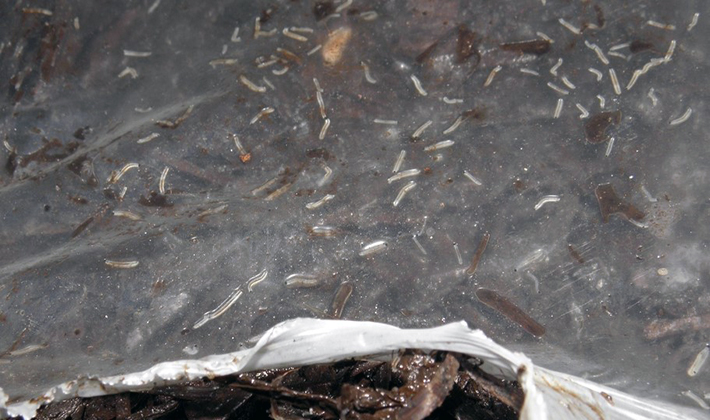
Nematodes also are some of the pests of cultivated mushrooms. They are small worms 0.5 mm long. Their mouthparts look like a dagger. They pierce the threads of mycelium on it. You cannot see them with the naked eye. They can almost always be found in champignon substrate. Nematodes are of various types: some suck out all the nutrients from the cells of the mycelium, reducing the yield of fungi; others alkalize the substrate by the products of their vital activity, thereby worsening its quality. The most dangerous are those nematodes that devour the mycelium.
A site affected by nematodes can be recognized quite easily. The substrate in such a place becomes dark, wet; in addition, it acquires a rather specific smell. Mycelium in this area never grows. Such barren zones are the first sign of nematode damage. If there are a lot of them, then they very quickly move to the stage of swarming. At this stage, columns of white color are formed on the coating material. They can be up to 0.5 cm high and represent tens and hundreds of thousands of individuals. Swarming nematodes are very easy to pick up from the substrate and transfer to another place. Moreover, this is carried out by both maintenance personnel and insects.
In order to avoid this, it is very important to observe all the necessary hygiene rules during the harvest season. After the collection is completed and before unloading the substrate, the room must be steamed.
Favorable conditions for the development of various nematodes are created during the fermentation of compost collar. The nematodes that appear in this case are resistant to many environmental conditions, even to high concentrations of hydrogen sulfide and ammonia. They are only afraid of fever. Therefore, the substrate for prophylactic purposes should be well interrupted and pasteurized.
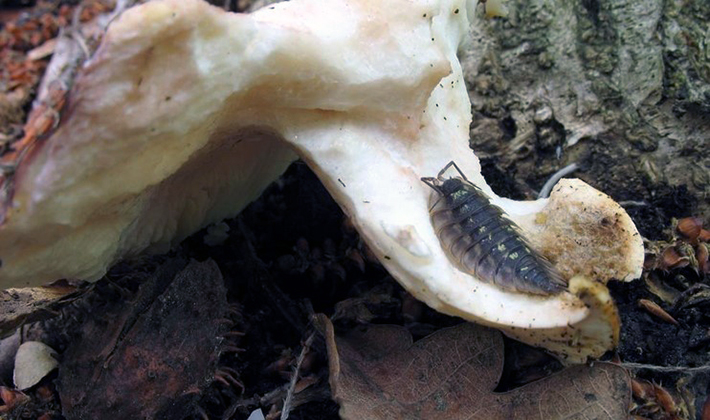
Woodlice, Tailings also harm cultivated mushrooms. They affect the mycelium. These invertebrates live in the soil and enter the substrate when it comes into contact with the soil. Therefore, you can not prepare the substrate on the ground or arrange beds on the earthen floor.
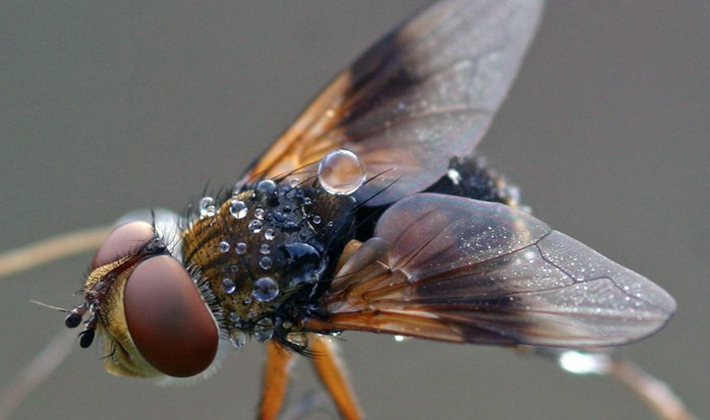
Dung fly It is also one of the pests of cultivated mushrooms. Her female lays 30 eggs in manure. The larvae that emerged from them enter the plantation along with manure. They are usually a few millimeters long, with black heads. Larvae are very voracious, eat fruiting bodies, gnawing moves in them. Very quickly, adults emerge from the larvae, which carry various diseases of fungi, as well as ticks and nematodes. Other types of flies are also harmful to mushrooms. This pest is usually dealt with using appropriate chemicals.
Mushroom Disease Prevention
All organisms ever get sick, there are no exceptions. It is known that any disease is easier to prevent than to cure. And mushrooms in this sense are no exception. All fungi suffer from viruses, parasitic fungi, and harmful insects.
The latter are often carriers of various diseases. In the mycelium, everything is interconnected, so it’s better to prevent the disease, than to treat it; especially since in some cases this is not possible.
Pest control during intensive mushroom cultivation is quite difficult, since most of the pests are located in the depth of the substrate and are not visible.
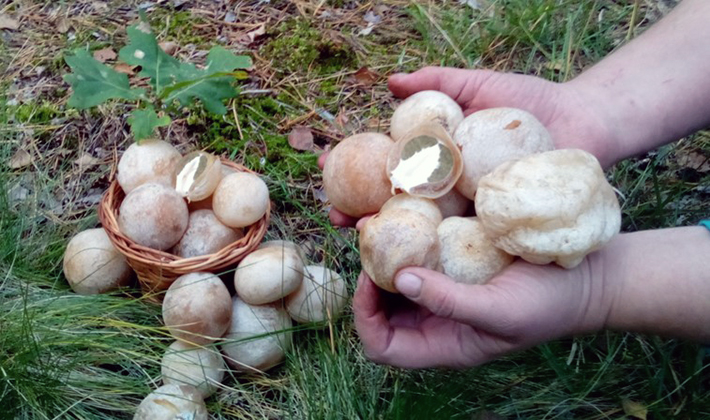
The main rule to prevent many diseases is the observance of sanitary safety measures in the mycelium. Parasites never give relief and do not forgive mistakes in pasteurization, composting, staff violations of sanitary rules and conditions for maintaining the microclimate. Many farms introduce a whole system of fines for violations of sanitary rules. Often this proves to be a fairly effective method.
The most common causes and sources of diseases and pests are unfiltered air, poorly pasteurized compost, poorly sterilized soil mixture, infected planting mycelium, dishonest sterilization of instruments, violation of sanitary rules in the mycelium.
Any disease that has settled in the mycelium immediately spreads in various ways. Viral diseases penetrate spores of fungi, using insects and ticks. Mushroom pathogens are transferred from the hands of workers during harvesting, from insects. Bacteria invade the mycelium with drops of water when watering, with adult insects. All pests themselves sprawl and scatter, hiding in all the small cracks of wood. It is almost impossible to get them out of there.
Jacques Delma, a French specialist, developed 10 commandments, the observance of which avoids almost all the troubles and problems associated with competing or parasitic organisms on fungi. These are the commandments.
It is imperative to disinfect everything related to mushrooms - these are premises, tools, equipment, boxes, mushroom baskets, etc.
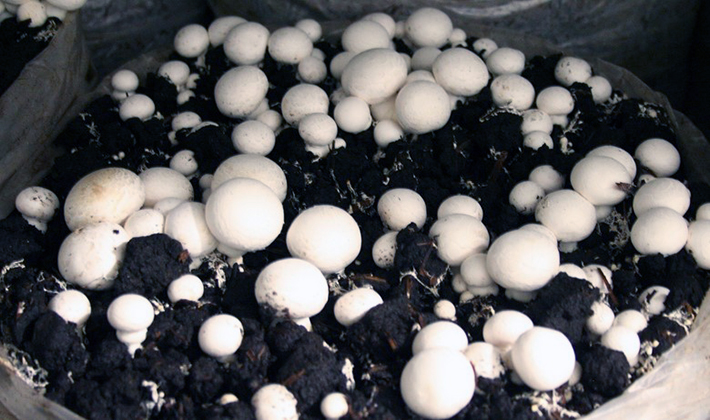
For growing mushrooms, you should choose isolated rooms so that foreign organisms cannot penetrate into them. All paths of penetration of diseases and pests need to be blocked.
The cover soil for growing mushrooms must be sterilized or taken already sterilized. A variety of microorganisms can live in it. Sterilized is a mixture that is treated with steam or formalin. Sterile soil is extracted from underground.
All waste must be disposed of immediately.
Sources of biological pollution, such as spent compost, manure, collected mushrooms, and production waste, cannot be left near the mycelium. It is also necessary to beware of chemical contamination. It can occur in the form of toxic fumes and vapors that spread through the ventilation system.
The room in which the disease arose should be immediately isolated from the rest and thoroughly disinfected.
Composting technology must be followed very precisely. Compost is only necessary on the concrete floor. Remember that in the earth there are often many different microorganisms, pathogens.
Compost should be prepared only at certain temperatures, humidity and aeration. Only in this case the substrate will be selective for the fungus, i.e. it will be suitable specifically for fungi, and not for competing microorganisms.
At all stages of the development of the fungus, one must always very zealously monitor the optimal microclimate conditions.
All work in the mycelium should be carried out in the direction from those rooms where the mushrooms are just starting to grow, to those in which the crop is harvested, that is, from young crops to old ones. You cannot move in the opposite direction.
Observance of these commandments always begins with the disinfection of premises. It should be carried out even in new mushrooms, before loading the compost. If it is a bomb shelter, a mine shaft or another room with stone walls, then their surface and ceiling must also be thoroughly washed. If the floor is earthen, then the top layer should be removed. Stone ceiling and walls need to be whitewashed. In this case, a 30% solution of copper sulfate is required to be added to the lime. Whitening is necessary regularly. This will guarantee clean, almost sterile air. In other rooms, the walls and ceiling must be treated with chemical protectants. They will be described below.
For microbiological protection of the substrate from various bacteria and viruses, thermophilic bacteria must be propagated in it.
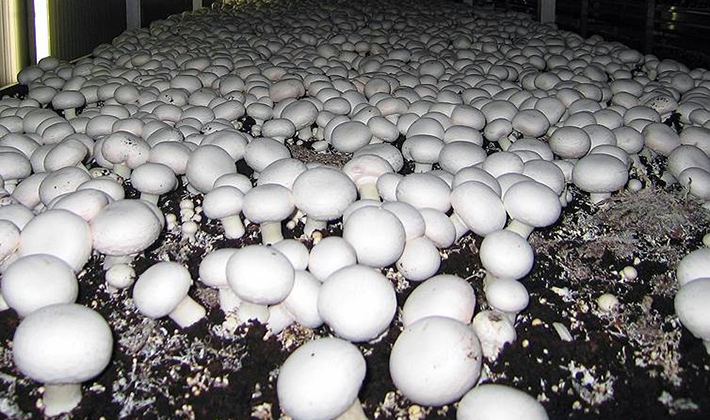
The most important thing in the mycelium is the disinfection of rooms at the end of cultivation and the neutralization of the used substrate. Everything else will be effective only if the first two conditions are met accurately. All pathogens and pests breed during a certain period of time. They need it for development, and only then will they begin to oppress the mycelium of the cultivated fungus. It is clear that the sooner they are in the mycelium, the more damage they cause. In this connection, the used substrate plays a decisive role, since it is in it that spores, larvae of pathogens and pests remain. If the old substrate is removed on a stretcher or wheelbarrows, then its remnants, even the smallest particles, may accidentally fall out along the road. If the used substrate is piled next to the mycelium or taken out on the same transport that is used for the new substrate, then in such cases there will not be a good crop.
Spent substrate can be removed in two ways. At the first it is taken out and disinfected. But it is better to take it as far as possible or sell it to the owners of greenhouses. However, the substrate should be moistened with water or a 4% solution of formalin, 1% solution of copper sulfate or chlorinated phenol. Wet substrate is safer than dry. In the second method, the substrate must be decontaminated in place or carried out its thermal treatment. In any case, the camera must be treated thermally. There are two ways to disinfect: by steaming and chemically. When steaming, the room is treated for 12 hours at a temperature of 70–100 ° C. In the corner farthest from the steam source, an electronic thermometer should be placed at the bottom of the compost and monitor its readings. Introduce water vapor into the chamber. When the temperature rises to 70 ° C, start a countdown. The mushroom picker must be thermally insulated, and the thermal insulation layer itself must be positioned so that steam does not get on it.If the internal walls are not tight, they should be covered with plastic wrap. This measure will help destroy pathogens. The building support system must withstand all temperature changes. Unprepared for this building very quickly become worthless. If mushrooms are bred massively, then steam sterilization is the best way. This method is also the safest.
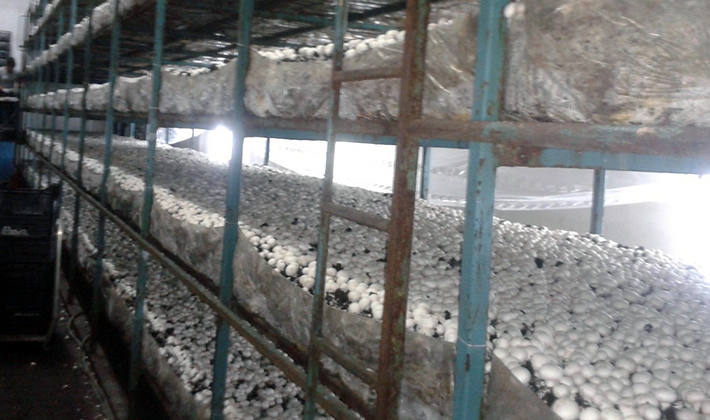
In small mushrooms at the base on the occasion of prepared buildings, it is better to carry out chemical thermal treatment. The easiest way is as follows: powder sulfur must be mixed with ammonium or potassium nitrate in a ratio of 1: 3, placed on iron baking sheets and set on fire. At the same time, the room is tightly closed. Sulfur gas will turn out, which will disinfect the room. The concentration of sulfur dioxide in this case should not exceed 40 mg / m. Otherwise, the room will be very difficult to ventilate. Then you need to air it for at least 10 days.
The most reliable way is to fumigate the room with methylene bromide. High-quality sterilization occurs at a temperature of 20–25 ° C at a dose of 600 g per hour / m, as if the room was treated with 1% methyl bromide for 17 hours. But within 16 hours, the concentration of a chemical (fumigant) decreases by 2 times, therefore Experienced specialists usually prepare a double dose in advance. Methylene bromide should be used together with 2% chloropyrkin, since the first substance is odorless, and tear gas will immediately detect its leak.
Wooden structures always serve as a good refuge for various insects and pests. In addition, they tolerate the treatment with steam rather poorly, as they quickly soak. That is why all wooden buildings must be impregnated with sodium parachlorophenolate or sodium pentachlorophenolate. They will not only protect the tree from decay, but will also serve as an obstacle to all insects. Alternatively, after each heat treatment, it is possible to wet the wooden parts with a solution of bleach and carbolic acid. The treated mixture is disinfected with the same mixture.
You can combine steam treatment with chemicals. For example, first treat all walls, floors, racks with chlorophos and cuprosan and then steam everything for 6 hours. Or treat the room with concentrated 40% formalin or a mixture of copper sulfate with lime. First, the walls, floor and ceiling should be washed with a 1% solution of alkali chloride. Then fumigate the room with formaldehyde. On 100 square meters, you need to take 2 liters of 40% formalin and 400 g of bleach. Chlorine lime is placed in open enameled or porcelain containers. Place limeware on the floor throughout the room, add formaldehyde. It will form formaldehyde gas, which will envelop the entire room. Pour formaldehyde in the direction from the inside of the room to the exit. The whole process needs to be carried out very quickly. Then close the door for 2 days. Then ventilate the room for 4 days.
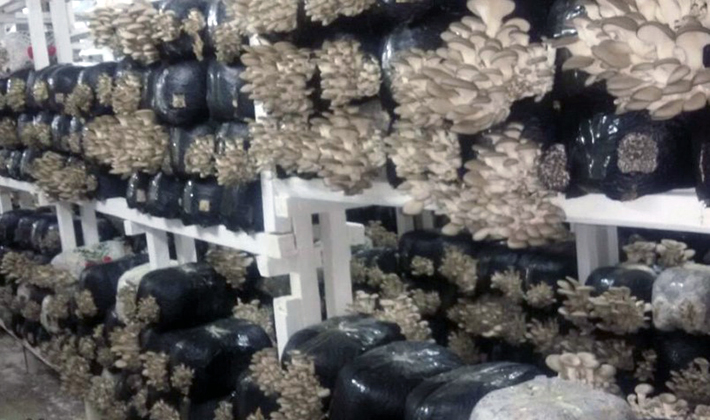
You can spray it with a 4% solution of bleach. Why dilute the right amount of lime in a small amount of water. This is best done in a wooden bowl. Then add water to get a solution of the required concentration, and leave to infuse for 2 hours. The solution needs to be sprayed into the room. Then close it for 2 days. This procedure should be carried out 15 days before the introduction of the substrate. Chlorine must all evaporate.
Formalin can also spray the room. For 10 liters of water, take 0.25 liters of 40% formalin. For 100 m of space, 20 l of solution will be required. The room should be well sprayed and tightly closed for 2 days. Then ventilate.
Formalin - a tool necessary for growing mushrooms. But it practically does not protect against harmful insects and does not always destroy fungal spores.
The source of infection is often dust with spores. In front of each door you need to put a wet mat soaked in disinfection.Everyone who enters the room must step on it. In addition, every morning you should water all the passages with a 2% formalin solution. Soak all tools in the same solution.
For the harvest you need to use new baskets every time. Boxes are better not to take. If old baskets are taken, then they must certainly be disinfected in a solution of bleach. If mushrooms are grown in plastic bags, then they do not need to be decontaminated, since they are used only 1 time. Wooden boxes are required to be cleaned and disinfected after each harvest. The latter should be carried out very often with steam for 12 hours, or for this purpose immerse all objects in a solution of one of the disinfectants, for example sodium pentachlorophenolate. At the first signs of the appearance of nematodes, you must immediately get rid of the old containers and acquire a new one.
It is very difficult to protect mycelium from extraneous harmful microorganisms. They are able to get inside with tools, equipment, on clothing, with integumentary soil, compost, and ventilation. All items that are brought into the mycelium must be decontaminated first. Air from the ventilation system should be filtered. It is especially important to do this during the period of growth and development of the mycelium. For this purpose, you can take like filters. If a large volume of air is driven, then in this case it is better to use a water curtain, that is, to pass air through a curtain of water drops, as through a waterfall.
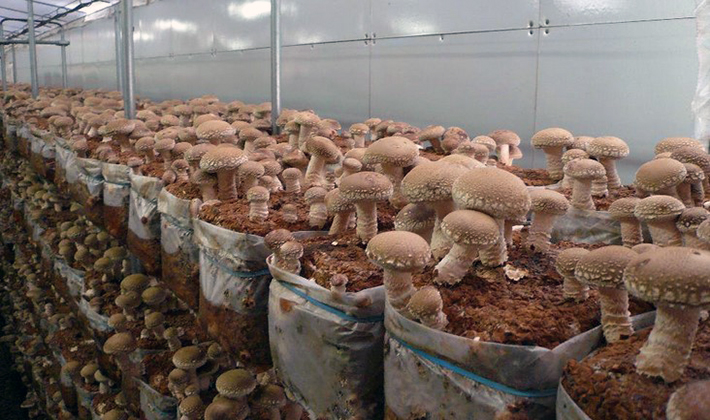
There is such a thing as an “infection entry gate”. The area near the entrance to the mycelium - this is the gate and infectious diseases of the mushrooms - must be clean. A compost heap should be arranged as far as possible from the entrance. Also, with its location, it is necessary to take into account such a factor as wind. It is better to arrange a compost pile with the side leeward from the entrance. Near the entrance to the mycelium there should not be dense thickets of shrubs, landfills, as they are natural sources of infection.
Industrial sources of air pollution, if present nearby, should also be considered.
Despite all such protective measures, many mycelium can be infected with parasites. In this case, the only measure to stop the spread of infection will be the complete isolation of these premises. They must be disinfected, not paying attention to the crop. Why they are usually sprinkled with potassium or common salt, chalk, watered with formalin, treated with methylene bromide, that is, it is permissible to use any potent substance that can destroy the source of infection. Also, in infected rooms, thermal treatment is carried out ahead of schedule.
All technological methods in the preparation of the substrate and compost must be strictly observed. This is one of the main measures to combat diseases. On well-prepared compost, mycelium develops very quickly and inhibits the development of other microorganisms. This property of compost is called selectivity. It means creating the conditions for the growth of a certain organism. The selectivity of the substrate is determined quite easily - this is if its temperature and humidity correspond to the conditions necessary for the successful bearing of mushrooms.
All work should begin where the mycelium is at an early stage of development, and move to those rooms in which the cultivation process ends with the harvest. It is there that parasitic and competing organisms accumulate, and the ability to resist them in fungi, on the contrary, decreases. Harvest should be collected and cleaned in the specified order - from young to old mushrooms. Air is also required to purge in the same direction - from young cultures to old ones. Such details must be immediately taken into account when designing a room. When moving from one zone to another, you need to wash your hands with soap and disinfect tools.When harvesting, do not pick up diseased mushrooms - they must be collected separately from healthy ones.
It is necessary to note one more point. Mushrooms, even when indoors, always feel the change of seasons. And the peak incidence is always in the summer. Therefore, it is necessary to cultivate mushrooms so that the beginning of their cultivation does not fall in the summer.
A few words about pesticides and other solutions. First, all pesticides for the prevention of fungal mycelium diseases should be used in mycelium only in low concentrations. They can also be included in the composition of the coating mixture or compost, or dissolved in water and poured with this solution of the garden. It is necessary to remember that over time pathogens develop resistance to the applied pesticides, so they must be periodically replaced with new ones. There are many different types of pesticides. In addition, science does not stand still, and new drugs appear every day. But their basis is almost always the same.
Against viruses, drugs have not yet been created, so you should use only healthy planting material. You also need to put a good filter on the supply air and conduct heat treatment in a quality manner, in which spores of fungi would die, because it is through them that the bulk of the viruses are transmitted.
There is one very effective remedy against bacteria: beds should be watered with a 0.25% solution of bleach. But at the same time, a black zone should not form in the cover layer. It should be noted that almost all aqueous solutions with halogens are good against bacteria.
Malathion, diazinon, dichlorvos, endosulfan and other insecticides will help to get rid of insects. Diazinon is a prophylactic; they treat empty mycelium inside and outside between crops once a month. If pasteurization is carried out on shelves in chambers, then the treatment with diazinon must be carried out before pasteurization, seeding and hobbling.
Dichlorvos in the cells is treated every week. It is also used for a sharp increase in the number of insect pests. For example, with the massive development of springtails, the floor and walls in the chambers must be sprayed with a 0.03% dichlorvos solution. Many experts immediately alternate 2 insecticides. Pests in this case are difficult to adapt. Of course, during thermal processing and pasteurization of the substrate, it is necessary to destroy all insects - in each gap and crack, filter the air.
All sanitary measures are very important in the fight against fungal competitors and parasites. It is undesirable to fight solely by chemical means, since fungicides can damage the crop. The most effective systemic fungicide is benomyl. It can also be found under the names of foundationazole and benlat. These drugs contain the same active substance, but are produced by different companies. Fundazole is used in a higher concentration than the other 2 drugs, since it is slightly worse in quality.
It is administered in a dosage of 15 g / m before filling while moistening the coating mixture. If there is a real threat of an outbreak of white or dry rot, mold, then the dosage should be increased to 45 g / m. With a mushroom disease, the mycelium should be treated with the drug in a dose of 1 g / m. You can also use mankozeb, kineb, maneb.
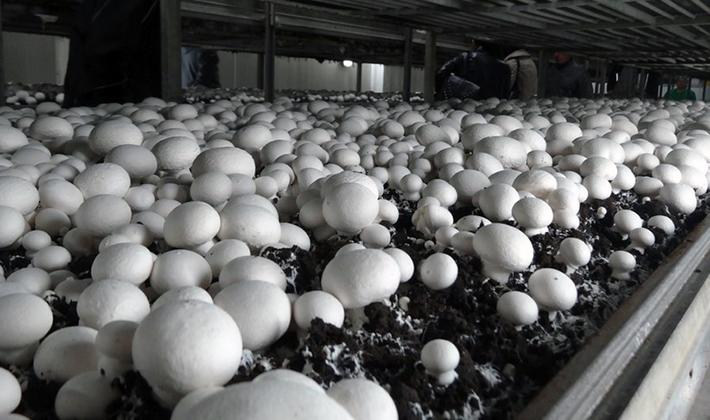
The fight against nematodes and ticks is more difficult to organize. They accumulate in compost and feed on the fungus mycelium. Here, first of all, it is necessary to pasteurize the substrate well. Against nematodes, parachlorophenolate and pentachlorophenolate can be used. They impregnate all the wooden parts and objects. They can also spray the camera a few days before making compost. These drugs are powerful antiseptics. They are also easy to replace with other antiseptics, such as carbolic acid. It should be remembered that not all chemicals decompose or volatilize. Many accumulate in the fruiting bodies of mushrooms.Therefore, chemical agents for controlling diseases, parasites and pests need to be used very carefully and in small quantities. Also, do not use the same processing standards that are given in books for gardeners and gardeners, although the drugs used are the same.
If mushrooms are almost ready for their collection, then chemical agents against pests and diseases cannot be used. Here you can apply herbal infusions. They are safe compared to chemicals. Also, if they spray the mushroom, then immediately after that you can take and eat. Of course, herbal infusions have a rather mild effect and do not completely solve the problem as chemical agents do. But they are also capable of being effective. It should be noted that there is no exact data on the use of such infusions, so they should be used carefully, as they can cause changes in the taste, color and smell of mushrooms.
Garlic sprayer repels insects and fungal diseases. Its action lasts up to 10 days. To prepare such an infusion, you need to chop 90 g of garlic with a garlic squeezer, pour 10 ml of unflavored oil into the pulp. After two days, mix the oil mixture with a soap solution. The latter is prepared as follows: 10 g of soap should be dissolved in 500 ml of water, mix well and leave for a day. Then strain the mixture and store in a tightly sealed container. The spray solution is prepared as follows: 1 part of the mixture is diluted in 100 parts of water. If the degree of infection is high, then you need to take less water.
You can also make infusions of some herbs. For example, lavender and tansy repel flies. To prepare the infusion, fresh or dry raw materials should be poured with boiling water. Here it is not necessary to observe proportions - the strength of the infusion depends on the degree of infection of the mycelium.
